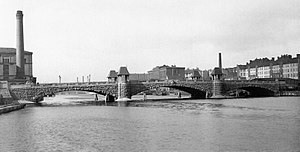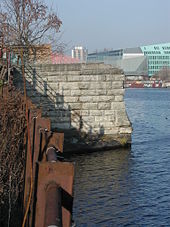Brommy Bridge
Coordinates: 52 ° 30 ′ 20 ″ N , 13 ° 26 ′ 12 ″ E
| Brommy Bridge | ||
|---|---|---|
| Brommy Bridge 1910 | ||
| use | Road traffic | |
| Convicted | (Eisenbahnstrasse) - Brommystrasse | |
| Crossing of | Spree | |
| place | Berlin-Friedrichshain , Berlin-Kreuzberg | |
| construction | three-span stone arch bridge | |
| overall length | 95.0 m | |
| width | 18 m | |
| Longest span | around 30 m | |
| Clear height | 4.5 m | |
| start of building | 1907 | |
| completion | 1909 | |
| planner | Architect: Alfred Messel , engineering company: Dyckerhoff and Widmann ; Jewelry: Ignaz Taschner |
|
| location | ||
|
|
||
The Brommybrücke was a road bridge over the Spree in Berlin and was located between the Schillingbrücke and the Oberbaumbrücke . As a northern extension of Eisenbahnstraße, Brommystraße led from Kreuzberg to Friedrichshain to Mühlenstraße (near Rummelsburger Platz). The bridge was built from 1907 to 1909, destroyed in 1945 during World War II; Reconstruction has been a topic of conversation since the fall of the Berlin Wall.
history
In 1851 a single-track railway bridge was built between Luisenstadt and Mühlenstraße , over which an inner-city railway line, the Berlin connection line , was led. This line was used to transport goods and connected, among other things, the terminal stations in Frankfurt and Hamburg station with each other. The river crossing of the connecting railway was designed as a swing bridge in the middle of the Spree so that ships could continue to travel unhindered. There was a narrow path sideways for pedestrian passages. Traffic congestion, dirt and noise for the residents finally led to the almost complete cessation of traffic on the connecting railway in 1871, only the coal transport to the gas works in Kreuzberg was still carried out.
In 1882, pedestrians were able to pass the bridge undisturbed by a raised superstructure. This crossing was already dilapidated in 1893 and had to be completely rebuilt, but there was still no direct road bridge. As coal soon no longer had to be transported by rail on this route, the swing bridge was no longer used, but it was an obstacle for the boatmen, and they requested the municipal authorities to demolish it.
Instead, a new bridge suitable for road traffic was planned, for which a new road had to be laid from the Eisenbahnstraße to the Spree crossing, namely where the railway line previously ran. Alfred Messel received the order to design the new bridge. Messel planned the construction of a three-bay arched bridge made of stamped concrete . Granite cladding was planned for the underwater part, and Franconian shell limestone cladding for the visible part . By imperial decree, this bridge was given the name Brommybrücke in honor of Admiral Brommy (actually Karl Rudolf Bromme ) on June 15, 1906 - before construction began in 1907 . The construction company Dyckerhoff & Widmann AG carried out the stamped concrete work.
On December 4, 1909, the 18-meter-wide and 95-meter-long Brommy Bridge was opened to traffic. On each side of the two central cantilevered bridge piers rose shelters, the corner pillars of the railing were adorned with sculptures by Ignatius Taschner , who was also involved in the figures at the fairy tale fountain in the Friedrichshain park . These sculptures depicted putti sitting on fabulous fish-tailed animals such as dogs, lions, eagles and rams. The street now leading over the bridge was named after the naval officer and rear admiral Karl Rudolf Brommy .
- The bridge sculptures
During the Second World War , this bridge was blown up to make the advance of the advancing Red Army more difficult. In contrast to other important traffic bridges, the Brommybrücke was not rebuilt. Except for the pillar remains in the river, all bridge components were cleared in 1950/1951. Factories and residential buildings on Brommystrasse leading to the bridge were relocated or demolished. The subsequently leveled strip between the banks of the Spree and Stralauer Allee lost all evidence of a bridge that began here earlier with the construction of the wall and the soon-to-be-followed interior wall (now known as the East Side Gallery ). The Brommystraße , which actually no longer existed , was still included in official documents until 1974.

From 1990 this stretch of road appears again on the official survey maps. It was not until 1977 that the bridge piers and the abutment on the north side were completely removed. Shortly before the fall of the Berlin Wall , in late summer 1989, there was an agreement between the East Berlin administration and those responsible on the West Berlin side to demolish the southern pillar of the Brommy Bridge that had remained in the river, for which the East Berlin budget 1.75 Millions of marks were planned. The events of November 9th, 1989 and the subsequent developments in Berlin prevented this work.
From the Oberbaum Bridge to the Schilling Bridge, the Spree was also part of the inner-German border between 1945 and 1990 ; it separated the Soviet and American sectors from Berlin. After the wall was built in August 1961, people who wanted to flee tried again and again to leave the eastern sector in this way. In the area of the Brommy Bridge, Werner Probst was shot by soldiers of the GDR border troops in mid-October 1961 while trying to escape over the remains of the bridge piers to Kreuzberg .
Planned new building
The Berlin Senate planned a reconstruction of the Brommybrücke in the 1990s (then around 2001 and finally from 2007). The new plans for the development of the river bank, the Mediaspree project, envisage the settlement of communications and media companies in this area on both sides of the Spree. A second traffic route across the Spree is therefore considered urgent again. The engineering company HL Hoffmann Leichter and the architect Gerhard Spangenberg have now drawn up an expert opinion and a project sketch, according to which a new modern Brommy bridge with a steel structure and two-story commercial units housed in it could be built for around 20 million euros (an "inhabited" bridge).
In order to make the south bank of the Spree at the abutment and the remaining bridge piers accessible to the public again, a viewing platform was built on the stable remains in 2007, reminiscent of the former bridge with the name Spreebalkon (also called Brommybalkon ). On September 5, 2007, the District Assembly (BVV) Friedrichshain-Kreuzberg decided to build a new bridge at a historic location, which is to be designed for all road traffic, but initially only to be used by local public transport , cyclists and pedestrians.
The start of construction was planned for 2009. However, because of the general financial crisis and massive resistance from various groups, the Berlin Senate was unable to implement the new building plans it had pursued so far. In February 2008, public thought was given to a cheap version of the bridge that would serve cyclists and pedestrians and should therefore cost “only” around 2.5 million euros. In the referendum “Spreeufer für alle!” In July 2008, the population voted in favor of building only a cycle / pedestrian walkway instead of a road bridge.
In the years that followed, the Senate Administration only pushed ahead with the preliminary planning, according to which the construction will now cost around four million euros. Actual construction activities have not started (as of January 2016).
At the end of September 2018, activists of the “Netzwerk Fahrradfreundliches Friedrichshain-Kreuzberg” set up a bright pink bicycle on the remaining bridgehead of the Brommybrücke and, facing the so-called Spreebalkon, attached a banner with the inscription “By bike and on foot - here across the river” to express their demand for construction to start.
In March 2019, BVV confirmed its will to rebuild the bridge and is looking for ways to finance it.
literature
- Thiemann, Deszyk, Metzing: Berlin and its bridges. Jaron Verlag, Berlin 2003, ISBN 3-89773-073-1 .
- Frank Eberhardt: A forgotten bridge . In: Berlin monthly magazine ( Luisenstädtischer Bildungsverein ) . Issue 9, 1997, ISSN 0944-5560 ( luise-berlin.de ).
- Wanja Abramowski : The Friedrichshainer Brommybrücke. In: mont klamott , issues 36–38 (2008), ed. from the Friedrichshain history association Hans Kohlhase e. V.
Web links
- Brommy Bridge. In: Structurae
- Information on the opening of the Spreebalkons and the further planning, status 2007
- All design sheets by Alfred Messel for the Brommybrücke in the architecture museum of the TU Berlin
- Bicycle friendly network Friedrichshain-Kreuzberg calls for the reconstruction of the Brommybrücke, as of 2018
Individual evidence
- ↑ Mentioned in various catalogs and commemorative publications of Dyckerhoff & Widmann AG / DYWIDAG.
- ↑ Street directory with residential districts and the most important social institutions and organs in the Friedrichshain district. Ed .: Council of the Friedrichshain District, January 1, 1974, p. 5
- ↑ Documentation / short portraits of the victims of the Berlin Wall 1961–1989 at berliner-mauer-gedenkstaette.de
- ↑ Homepage of the architect Spangenberg with the project sketch Neue Brommybrücke ( memento of the original from October 6, 2010 in the Internet Archive ) Info: The archive link was inserted automatically and has not yet been checked. Please check the original and archive link according to the instructions and then remove this notice. Retrieved May 15, 2009
- ↑ Dream of a new Brommy bridge . In: Welt Online , February 12, 2006
- ↑ Four and a half meters above the Spree . In: Berliner Zeitung , May 4, 2007
- ↑ BVV Friedrichshain-Kreuzberg, resolutions of September 4th and 5th, 2007 for the SPD (DS / 0255 / III) and Alliance 90 / The Greens (DS / 0305 / III, DS / 0271 / III)
- ↑ Inexpensive variant for Brommybrücke is being examined. There is no money to build the Brommybrücke. A new plan has to be found - if possible one that is cheaper . In: Tagesspiegel , February 2, 2008
- ↑ Stefan Jacobs: Who should actually use the Brommy Bridge? , In: Der Tagesspiegel , March 6, 2013, accessed on January 8, 2016.
- ↑ Tagesspiegel , District wants to "initiate" Brommybrücke , March 29, 2019







